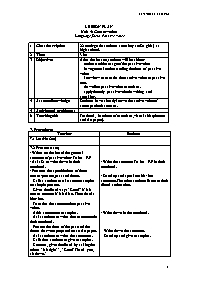Lesson plan - Unit 4: Conservation - Language focus: Passive voice

Class description 22 tenth-grade students ( one boy and 21 girls) at high school.
Time 35m
Objectives After the lesson, students will be able to:
+ understand the usage of the passive voice
+ have general understanding the form of passive voice
+ know how to transfer from active voice to passive one.
+ do well on passive voice exercises.
+ apply fluently passive voice in writing and speaking.
Assumed knowledge Students have already known the active voice of some particular tenses.
Anticipated problem(s)
Teaching aids Textbook, handouts of exercises, visual aids (pictures and A0 paper).
Bạn đang xem tài liệu "Lesson plan - Unit 4: Conservation - Language focus: Passive voice", để tải tài liệu gốc về máy bạn click vào nút DOWNLOAD ở trên
LESSON PLAN Unit 4: Conservation Language focus: Passive voice 1 Class description 22 tenth-grade students ( one boy and 21 girls) at high school. 2 Time 35m 3 Objectives After the lesson, students will be able to: + understand the usage of the passive voice + have general understanding the form of passive voice + know how to transfer from active voice to passive one. + do well on passive voice exercises. + apply fluently passive voice in writing and speaking. 4 Assumed knowledge Students have already known the active voice of some particular tenses. 5 Anticipated problem(s) 6 Teaching aids Textbook, handouts of exercises, visual aids (pictures and A0 paper). Procedure: Teacher Students 7.1 Lead-in (2m) 7.2 Present (11m) - Writes on the board the general structure of passive voice: To be + P.P - Asks Ss to write down in their notebook. - Presents the specific form of three tenses: present, past and future. + Calls a student to take some examples on simple present. + Gives feedback: says "Good!" if it is true or corrects if it is false. Then thanks him/ her. + Transfers the sentence into passive voice. + Adds some more examples. + Asks students to write those sentence in their notebook. + Present the form of the past and the future that were prepared on an A0 paper. + Asks students to write the structures. + Calls four students to give examples. + Corrects, gives feedback by asking the others "Is it right?", "Good! Thank you, sit down." - Write the structure To be + P.P in their notebook. - Stand up and speak out his/ her sentence. The other students listen to their friend and teacher. - Write down in the notebook. + Write down the structure. + Stand up and give examples. 7.3 Practice (11m) Activity 1: Gives each student a piece of paper which has three sentences in active voice (can be extracted from the textbook). - Asks Ss to work individually in 3m to transfer those sentences into passive voice. - Stops Ss after 3m. - Calls Ss to read aloud their sentences. - Corrects the answers. Activity 2: Divides the class into 11 pairs. - Gives each pair a pair of incomplete sentences. - Asks Ss to use the given words to write the full sentences using passive voice. - Calls Ss to read their sentences. - Corrects the answer of Ss - Receive a piece of paper. - Work individually to finish the exercise. - Stop writing. - Stand up and read aloud their sentences. - Sit in pairs - Receive the incomplete sentences. - Write the full sentences with passive voice using the words given. - Stand up and read their complete sentences. 7.4 Production (11m) - Divides the class into 4 groups ( 2 groups of 5 and 2 groups of 6 Ss). - Gives Ss situation: "Imagine that you are working in a recycling paper factory. There are groups of students visit your factory and want to know about the process of recycling paper. You tell them about how paper is recycled". - Asks Ss to discuss the process of recycling paper, then use passive voice to describe to the others. - Gives each group 1 minute to present their description. - Asks the other group to listen. - Corrects and gives comments. - Sit in groups of 5 or 6. - Listen to the situation and teacher's instruction (3m). - Discuss in group (4m) - Present in 1 minute - Listen to the presenter(s) - Listen to teacher's comments 8. Summary and Homework: remind students what they have learnt and asks them to finish 3 exercise in the textbook.
Tài liệu đính kèm:
 Unit 10 Passive voice.doc
Unit 10 Passive voice.doc





